Supermarine Spitfire
Mitchell developed the Spitfire's distinctive elliptical wing (designed by Beverley Shenstone) with innovative sunken rivets to have the thinnest possible cross-section, achieving a potential top speed greater than that of several contemporary fighter aircraft, including the Hawker Hurricane.After the Battle of Britain, the Spitfire superseded the Hurricane as the principal aircraft of RAF Fighter Command, and it was used in the European, Mediterranean, Pacific, and South-East Asian theatres.The 224 was an open-cockpit monoplane with bulky gull wings and a large, fixed, spatted undercarriage powered by the 600-horsepower (450 kW), evaporatively cooled Rolls-Royce Goshawk engine.[7] It then went through a series of changes, including the incorporation of an enclosed cockpit, oxygen-breathing apparatus, smaller and thinner wings, and the newly developed, more powerful Rolls-Royce PV XII V-12 engine[nb 1], which was later named the "Merlin".[9] In April 1935 Ralph Sorley spoke to Mitchell about the new specification F10/35 which called for armament of at least six and preferably eight guns while at the same time removing bomb carry requirement and reducing fuel capacity.[23] A new and better-shaped, two-bladed, wooden propeller allowed the Spitfire to reach 348 mph (557 km/h) in level flight in mid-May, when Summers flew K5054 to RAF Martlesham Heath and handed the aircraft over to Squadron Leader Anderson of the Aeroplane & Armament Experimental Establishment (A&AEE).In 1936, this informal request for major manufacturing facilities was replaced by a formal scheme, known as the shadow factory plan, to boost British aircraft production capacity under the leadership of Herbert Austin.Difficulties arose with management, who ignored Supermarine's tooling and drawings in favour of their own, and the workforce continually threatened strikes or "slow downs" until their demands for higher wages were met.If all appeared satisfactory, I would then put her into a dive at full power and 3,000 rpm, and trim her to fly hands and feet off at 460 mph (740 km/h) IAS (Indicated Air Speed).The French Dewoitine D.520[56] and the German Messerschmitt Bf 109, for example, were designed to take advantage of new techniques of monocoque construction, and the availability of new, high-powered, liquid-cooled, in-line aero engines.[57] Mitchell's design aims were to create a well-balanced, high-performance fighter aircraft capable of fully exploiting the power of the Merlin engine, while being relatively easy to fly.As the wing thinned out along its span, the tubes were progressively cut away in a similar fashion to a leaf spring; two of these booms were linked together by an alloy web, creating a lightweight and very strong main spar.[70] The undercarriage legs were attached to pivot points built into the inner, rear section of the main spar, and retracted outwards and slightly backwards into wells in the non-load-carrying wing structure.[71] In turn, the leading-edge structure lost its function as a condenser, but it was later adapted to house integral fuel tanks of various sizes[72]— a feature patented by Vickers-Supermarine in 1938.[80][81] During the Battle of Britain, pilots found the Spitfire's ailerons were far too heavy at high speeds, severely restricting lateral manoeuvres such as rolls and high-speed turns, which were still a feature of air-to-air combat.[88][89] As the Spitfire gained more power and was able to manoeuvre at higher speeds, the possibility that pilots would encounter aileron reversal increased, and the Supermarine design team set about redesigning the wings to counter this."[97] However, the early Merlin engine's lack of fuel injection meant that Spitfires and Hurricanes, unlike the Bf 109E, were unable to simply nose down into a steep dive.[104] At that meeting, scientific officer Captain F. W. "Gunner" Hill presented charts based on his calculations showing that future fighters must carry no fewer than eight machine-guns, each of which must be capable of firing 1,000 shots a minute.[113] Some notable Commonwealth pilots were George Beurling (311⁄3 e/a) from Canada, "Sailor" Malan (27 e/a) from South Africa,[114] New Zealanders Alan Deere (17 e/a) and C F Gray (27 e/a)[115][116] and the Australian Hugo Armstrong (12 e/a).Sometimes unarmed, they flew at high, medium, and low altitudes, often ranging far into enemy territory to closely observe the Axis powers and provide an almost continual flow of valuable intelligence information throughout the war.[118] In the Mediterranean, the Spitfire blunted the heavy attacks on Malta by the Regia Aeronautica and Luftwaffe, and from early 1943, helped pave the way for the Allied invasions of Sicily and Italy.[129] Spitfire MKVIIIs took part in the last battle of World War II involving the Western allies in Burma, in the ground attack role, helping defeat a Japanese break-out attempt.[131] The 4th Fighter Group comprised the former RAF Eagle Squadrons, which transferred into American service in September 1942, the volunteer pilots bringing their Mark Vb Spitfires with them.[134] Beginning in late 1943, high-speed diving trials were undertaken at Farnborough to investigate the handling characteristics of aircraft travelling at speeds near the sound barrier (i.e., the onset of compressibility effects).In April 1944, the same aircraft suffered engine failure in another dive while being flown by Squadron Leader Anthony F. Martindale, Royal Air Force Volunteer Reserve, when the propeller and reduction gear broke off.[147] In the postwar era, the idea was revived by Supermarine and a number of two-seat Spitfires were built by converting old Mk IX airframes with a second "raised" cockpit featuring a bubble canopy.The basic Spitfire design did impose some limitations on the use of the aircraft as a carrier-based fighter; poor visibility over the nose, for example, meant that pilots had to be trained to land with their heads out of the cockpit and looking along the port cowling of their Seafire.[157] With these aircraft, 80 Squadron continued its patrol and reconnaissance duties from Wunstorf in Germany as part of the occupation forces, until it relocated to Kai Tak Airport, Hong Kong, in July 1949.[159] In late 1962, Air Marshal Sir John Nicholls instigated a trial when he flew Spitfire PM631, a PR Mk 19 in the custody of the Battle of Britain Memorial Flight, against an English Electric Lightning F 3 (a supersonic jet-engined interceptor) in mock combat at RAF Binbrook.Excavations carried out at Yangon International Airport (formerly RAF Mingaladon) in early 2013 failed to locate any of the rumoured aircraft,[177][178] and the team reported that they found no evidence that Spitfires were shipped there in crates or buried.
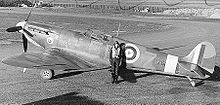
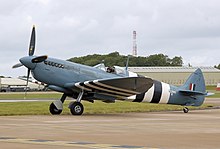
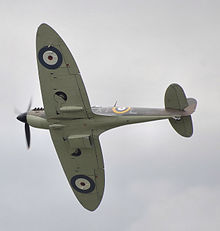

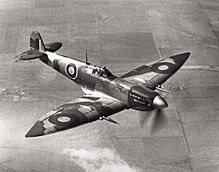




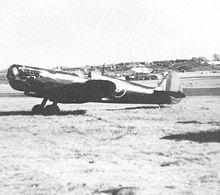






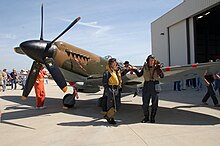


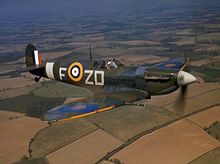
Spitfire (disambiguation)No. 222 Squadron RAFFighterInterceptorSupermarineR. J. MitchellIrish Air CorpsRoyal Air ForceRoyal Canadian Air ForceFree French Air ForceUnited States Army Air ForcesSupermarine SeafireSupermarine SpitefulRAF HaltonBiggin Hill Airportfighter aircraftAlliedWorld War II70 remain airworthyinterceptor aircraftVickers-Armstrongelliptical wingBeverley ShenstoneHawker HurricaneJoseph SmithairframeRolls-Royce MerlinRolls-Royce GriffonBattle of BritainLuftwaffeRAF Fighter CommandEuropeanMediterraneanPacificSouth-East AsianSeafireFleet Air ArmSupermarine Type 224specification F7/30Gloster GauntletBlackburn F.3Westland F.7/30undercarriageevaporatively cooledRolls-Royce GoshawkGloster GladiatorSchneider TrophyPV XIIRalph SorleyVickers machine gunsBrownings)the prototype (K5054)Eastleigh AerodromeSouthamptonCaptain Joseph "Mutt" SummersJeffrey QuillSydney CammRAF Martlesham HeathAeroplane & Armament Experimental EstablishmentRAF HendonWoolstonWalrusStranraerWellingtonBristol BeaufightersCastle Bromwich AssemblyRoyal Observer Corps41 SquadronMorris MotorsCowley plantshadow factory planHerbert AustinCastle Bromwich Aircraft Factoryaerodromemachine toolsLord NuffieldLord BeaverbrookMk IIsRAF AldermastonItchenReadingSalisburyCavershamHursley ParkWinchesterHigh PostTrowbridgeRAF KeevilHenleyAldermastonCommerQueen MaryAlex HenshawtrainersDewoitine D.520Messerschmitt Bf 109monocoqueFrance as an allyNorth Seasemi-monocoqueduralumin-skinnedformerslongeronslightening holesrudderalcladtailplanemain sparspruceinduced dragGünter brothersHeinkel He 70aerodynamicistNACA 2200 seriesthickness-to-chord ratiodihedralleaf springglycolRoyal Aircraft EstablishmentFarnborough, Hampshirecooling air to generate thrustpneumaticSpitfire Mk IXthermostatinvasion stripeswashout
